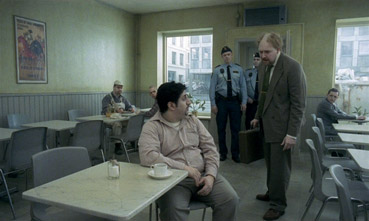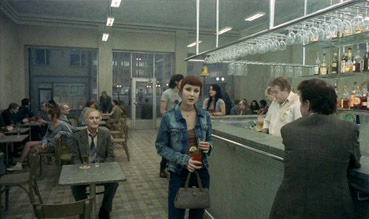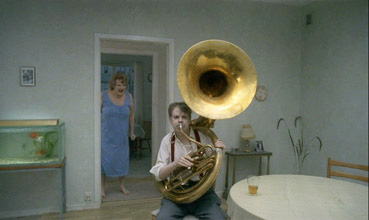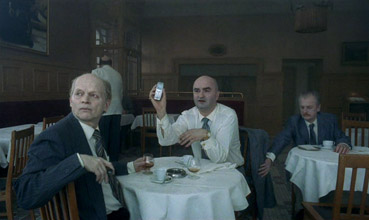|
There are certain films that each of us are predestined to love, a perfect match of movie and viewer that bypasses rational explanation and moves you into the area of unquestioning adoration. Find enough of them and be vocal about it and those around you will develop an understanding of the sort of thing that will instantly appeal to you, and with a bit of luck they'll point you in the direction of movies they are sure you will like.
Back in 2001 I was attending a meeting of county film society personnel, chaired by a regional festival organiser with whom I had worked a number of times. As a group we were discussing the high points and otherwise of the cinematic year, and Roy Andersson's Songs From the Second Floor came up. Our chairperson, it transpired, was not a fan of the film, but my face obviously lit up on the mere mention of the title, prompting her to smile, shake her head and say "I just knew you'd love that one."

If you've never seen Songs From the Second Floor then you really should, and if you can't lay your hands on a copy then fear not, as Andersson's new film, You, the Living [Du Levande], is essentially more of the same, and that's not intended as a criticism. Andersson has developed a most singular approach to filmmaking, and the elements common to both Songs and You, The Living are what continue to separate this particular director's work from, well, just about everything else around. Neither film tells a story in the traditional sense and instead consist of a patchwork of loosely connected vignettes of everyday life, each captured in a single, usually static wide shot and each, through a combination of camera placement, pace and performance, at the very least dipping its toes in the surreal and just occasionally taking a hot steaming bath in it.
Quite what Andersson is trying to say to and about us, the living, is not immediately clear, but it strangely seems not to matter. Life as observed by his expansive camera is shown to be, at least for us ordinary mortals, a string of frustrations and disappointments punctuated by small pleasures that are often enjoyed unknowingly at the expense of others. Tomorrow, we are more than once reminded here, is another day, and in the commentary on this very DVD Andersson ponders on whether that is something to be cherished or endured. For most, he believes, it is the latter, days defined by routine that is disrupted only by misfortune, the luckless timing that repeatedly places us in the wrong queue at a ticket office, leaves no room for us in a bus shelter when rain is bucketing down, or closes that lift door just before we reach it.
This may make the film sound like a glum experience, but the underlying pessimism is never allowed overwhelm or even seriously impinge on its joyously skewed presentation. From the first scene, Andersson paints reality with the brush of surreality, as a park bench argument between an overweight biker couple is musically counterpointed by an upbeat ragtime score that the dialogue falls in time with and ultimately becomes the lyrics to, the single-word backing vocal provided by a raincoat-dressed man who appears on cue from behind a tree. Any expectations that this will develop into a narrative are quickly dashed by the image of a line of chefs looking directly to camera through the window of their restaurant kitchen, which a walking-frame assisted old man shuffles slowly past, pulling a small dog that is writhing on its back in protest.

And so it unfolds. Over the course of the film, characters are introduced, disappear and reappear later, and from an early stage scenes start to subtly dovetail and interconnect with others. Thus a man who is driving his wife to distraction with his tuba practice (he too appears to be playing along with the score) is also the cause of anger for the occupant of the flat below, and both stories provide a distraction for a man grabbing a sneaky cigarette on the balcony opposite. Later the tuba player meets with fellow musicians for a practice session that is interrupted by Anna, a young girl with a fixation on rock star Micke. He reappears after to take part in a street parade, and later still contributes to the music at a funeral for a character whose heart attack unexpectedly concludes another story that has started three scenes earlier.
I could go on for pages like this, detailing the connections in the characters, their stories and the underlying themes, but joining these dots for yourself is one of the film's many pleasures. It may not lead to instant clarity, but it does paint an enjoyably left-field picture of interconnecting lives, though in a reversal of a recent cinematic trend, the effect of these actions is largely minimal – people move through Andersson's world in relative isolation, interacting with others but rarely disrupting their equally unremarkable paths.
But what makes You, the Living such a consistently delightful experience is Andersson's gift for staging even the simplest of activities in pictorially striking and sometimes hilariously offbeat manner. As with Songs, almost every scene is shot wide in a single take and with little in the way of camera movement (one movement is so subtle you only realise it has occured at all when the scene concludes), the deep-focus framing and organisation of characters on occasion looking like Edward Hopper and Giorgio de Chirico have collaborated on a string of Swedish interior studies. So carefully controlled is the imagery that, with one exception that you'll need the assistance of the commentary to spot, even the exteriors are actually studio sets, detailed and complicated constructs for shots that can last less than thirty seconds.
Highlights are plentiful, but the two dream recreations are definite standouts, the first for its absurdist humour (hearing that a construction worker has tried unsuccessfully to execute 'the tablecloth trick' becomes laugh-out-out funny when you see the tablecloth in question) and its sprinkling of socio-political digs, the second for what must rank as the most deliciously executed reveal I've seen all year, when the movement glimpsed through a kitchen window turns out not to be a passing train but... no, I'm not going to spoil this one. And surely there can be few directors who could prompt the widest of smiles from his audience with a static shot of an almost motionless tuba player rehearsing his music.

It may not all make complete sense on the first viewing, but a second run and a listen to the commentary definitely helps clarify both the detail and Andersson's overriding purpose. Either way, You, the Living is a richly imaginative delight, a film that manages to be pessimistic and hilarious in the very same breath, and one that understands the playful and satirical possibilities of surrealism better than anything since top-of-form Monty Python. A most worthy successor to the superb Songs of the Second Floor, it has me twitching in anticipation at the news that this is the second film in a proposed trilogy.
On the commentary track director Andersson talks about the likelihood of moving to digital if he can achieve the same tone as he has with film – it will be interesting to see, given the very specific look he has established in the first two films of this proposed trilogy. Every shot in You, The Living has been intricately constructed, as much for the locations themselves as the way characters move through (or, as in a few cases, remain static within) them. Given the importance of this imagery to the texture of the film, it's pleasing to see it so well reproduced here. Although not Hollywood pin-sharp, this is nevertheless a clean, detailed and well-balanced anamorphic 1.66:1 transfer that captures the film's pastel colour palette well, and although not exactly punchy, the contrast feels about right, retaining the shadow detail but without compromising the black levels.
A choice between Dolby 2.0 stereo and surround 5.1 sees the latter win out, but not by a huge margin. There is some surround activity on music and a few effects, but nothing specific and frontal separation is hardly dynamic. The location atmospherics are slightly fuller on 5.1 though, and the bass thump on drumbeats and thunder is impressive.
Director's commentary
A commentary? On an Artificial Eye disc? You'd better believe it, and it's a damned good one. Effectively fed by Ronny Svensson, director Roy Andersson provides a non-stop stream of interesting insights into the making of the film and the reading of key scenes, sometimes highlighting detail that might not be obvious to non-Swedes (the tabletop swastikas revealed by the construction worker's tablecloth trick, for example, are a reference to Sweden's refusal to confront its own pro-Nazi past). There are a few surprises about the production design and effects as well, including the revelation that the extraordinary, apocalyptic (and, one can't help but suspect, Dr. Strangelove inspired) final shot was created not through the expected CGI, but entirely with models. Andersson's personal politics and world view also prove fascinating, as he neatly describes modern Swedish capitalism as a "chain letter economy" and religion as "the state's lackey." Conducted in Swedish with English subtitles, this is a fine track that adds a great deal to your appreciation of the movie.

Scene Sequence (8:08)
A most unusual but illuminating extra, featuring static shots of what looks like every set used in the film, shots that then pull back to reveal them for the artificial constructions they are. There are some real surprises here, more if you watch it before listening to the commentary, particularly in the studio sets that I was convinced were exterior locations and the precise and convincing use of false perspective backgrounds. In the commentary Andersson mentions that a documentary exists on the construction of these sets, which this could well be part of and which I would very much like to see.
Excerpts from other Roy Andersson films (15:32)
Exactly what it claims, this usefully charts the development of Andersson's current style with sizeable extracts from all of his previous features.
Trailer (1:52)
A tricky one to sell, something this particular trailer illustrates.
My hopes were high after Songs of the Second Floor, but You, the Living is every bit as comically bizarre and beautifully crafted. Artificial Eye have delivered another fine transfer here, but the inclusion of a director's commentary and that intriguing featurette mark this as one of their best single film releases this year. Warmly recommended.
|